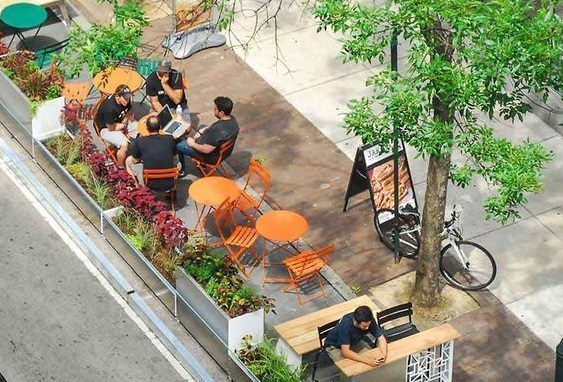

Transforming neglected crevices of neighbourhoods into community-oriented destinations is easier than it might appear, writes Peter Ciemitis.
How do you revitalise an underused, unattractive urban cul-de-sac into a buzzing, multi-use civic space that perfectly balances people, greenery, and cars? This common challenge that many urban planners and designers face can be combatted with several key considerations.
Communities struggle to thrive in neighbourhoods that home ill-considered infrastructure: streets will dispel foot traffic and engagement from local businesses particularly where footpaths are narrow, unkept and lacking greenery. Rather, neighbourhoods flourish in areas that accommodate widened footpaths for improved pedestrian accessibility and public alfresco seating, as well as green spaces that include rain gardens and street trees. In fact, increased green infrastructure can improve roadside air quality, assist with the management of storm water, and enhance the public realm. Street greenery and easy accessibility reduces sedentariness by promoting safe, outdoor recreation.
These considerations were recently applied to a project Hatch RobertsDay participated in with Perth’s City of Melville. We created two concept plans to transform a section of Ogilvie Road into a thriving, pedestrian-friendly and green precinct, and increase general foot traffic to the area.
Below are several ways planners can similarly revitalise streets:
- Address community concerns early. Often planning projects can become highly politicised, therefore holding public engagement sessions to walkresidents through both the site and discuss your idea may be beneficial. It is important to also consult with the local community, including business and landowners to take them through the design process and identify and address any concerns and broader needs. Change-averse stakeholders may be more accepting of a transformation if they have a clear understanding of how the enhancements will benefit their day-to-day.
- Calibrate land uses realistically. An area of urban planning that is not done well in Australia is calibration of land uses to streets. For instance, when redesigning urban streetscapes, planners tend to advocate for activated business frontages and nil-setbacks to every street. However, this only works for businesses that want to trade to passing foot traffic. Businesses such as offices and health centers will cover their exposed facades. The right activated frontages are ideal, not blank facades.
- Widen footpaths to encourage pedestrians and alfresco dining. Footpaths contribute to the mental and physical wellbeing of residents by facilitating physical exercise, and community and social cohesion. It can be challenging to hold a conversation on a narrow footpath, with the constant need to fall into ‘single file’ to allow oncoming pedestrians to pass. Widening footpaths strengthens existing social and cultural use by allowing for temporary recreational and commercial events such as markets and live music performances. Additionally, it encourages cafe patrons to sit outside, providing a safer option in the current post-COVID-19 climate.
- Add street furniture. Benches, streetlights, plant pots and safety bollards facilitate a sociable, inclusive, and safe atmosphere in urban environments. Sitting places foster rest and relaxation, thereby increasing time spent in a certain vicinity. The inclusion of benches and other sitting facilities assists older members of the community as it provides greater accessibility for individuals with mobility issues.
- Substitute some street parking with ‘parklets’. Converting a few curb side parking spaces into ‘parklets’ that fuse street greenery and public seating spaces can give pedestrians relief from the hustle and bustle of city living and boost local biodiversity. When developing a parklet, consideration should be given to its street barriers, wind protection and lines of sight to ensure a comfortable and safe sitting environment.
- Improve wayfinding, especially for off-street parking. Well placed street signs strengthen the legibility, navigation, understanding and accessibility of urban environments. They increase the utilisation of lesser-known places in a precinct – elements that smartphone maps don’t always identify.
- Blend pedestrian paving with the street. Safely integrating vehicle lanes with pedestrian pavements improve aesthetic appeal and indicate to traffic that they are entering a significantly different road environment. As shared zones allow pedestrian, cyclist and vehicle movement, there should be a coordinated design approach to maintain pedestrian safety, including consideration of the placement of trees, furniture, lighting, and paving.
- Introduce waterwise landscaping. Street greenery is essential to sustainable urban development as it improves mental and physical wellbeing through increased air quality, shading and the beautification of metropolitan infrastructure. Waterwise landscaping will have plantings that have lower water needs and can tolerate drought, groups together plants by water needs, and generally uses water more efficiently.
*Peter Ciemitis is WA Principal at a urban planning consultancy Hatch RobertsDay
Comment below to have your say on this story.
If you have a news story or tip-off, get in touch at editorial@governmentnews.com.au.
Sign up to the Government News newsletter
It is agreed that the pictures look nice.
However is there any evidence that the turnover of the various traders has increased year on year. That is the same month compared to the previous year before the alterations.
Please do not provide figures that include the opening week or month and all the street music etc put on that is not going to be permanent attractions.
If you say the intention is not to increase the turnover of the various traders sales numbers are still required. As a number of car bays directly relevant to the traders may have been lost it is interesting to see whether this has caused a loss in customer count and sales.
You would also be familar with the Covid impact on all things. An increase in sales – when compared – to a covid time may have nothing to do the street pretty up. All things always require careful analysis.